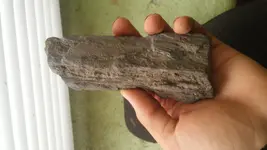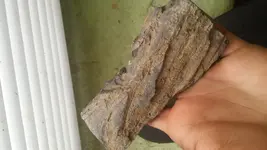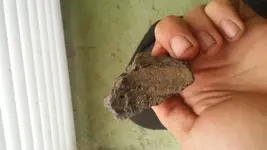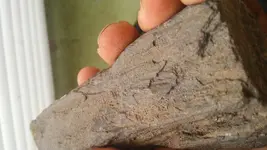You are using an out of date browser. It may not display this or other websites correctly.
You should upgrade or use an alternative browser.
You should upgrade or use an alternative browser.
What is this rock ?
- Thread starter ivobg
- Start date
Ponchosportal
Full Member
I would have guessed either siltstone or mudstone.
I agree except the bedding would be to complex and what appears to be the presence of SiO2?
Upvote
0
Eu_citzen
Gold Member
I agree except the bedding would be to complex and what appears to be the presence of SiO2?
Look at the first and last pic. Bedding looks simple enough.
Some presence of quartz is not unusual; in fact this is what made some of these useful for sharpening knives! (I use one in the kitchen; sharpening stone)
The unusual look might be due to some layers being more resistant to erosion then others. Thus the odd look.
Upvote
0
stdenis_jd
Hero Member
- Joined
- May 7, 2015
- Messages
- 513
- Reaction score
- 576
- Golden Thread
- 0
- Location
- West Lower Peninsula, MI
- Primary Interest:
- Prospecting
best bet is to do a hardness test on the non-weathered part of that rock, should be really close to 7 (6.5-7) as pet wood almost completely replaces its organic material with silica if I'm not mistaken.
Upvote
0
Ponchosportal
Full Member
Look at the first and last pic. Bedding looks simple enough.
Some presence of quartz is not unusual; in fact this is what made some of these useful for sharpening knives! (I use one in the kitchen; sharpening stone)
The unusual look might be due to some layers being more resistant to erosion then others. Thus the odd look.
There is nothing simple in bedding of the third photo. Nor is the deposition consistent with siltstone or mudstone.
The unusual look is absolutely because of slight differences in the competence/composition of the material resulting in the erosion you describe.
Upvote
0
Eu_citzen
Gold Member
There is nothing simple in bedding of the third photo. Nor is the deposition consistent with siltstone or mudstone.
The unusual look is absolutely because of slight differences in the competence/composition of the material resulting in the erosion you describe.
The third pic to me looks like it might indicate (low grade) hydrothermal alteration. If so, depositional characteristics might have been altered.
Note: perhaps I was mistaken on the other pics and we're seeing cleavage. (rather then bedding)
A Siliceous mud- or siltstone will also pass the hardness test if enough silica is present. (though likely thus bordering on sandstone?)
The 'grainy' and porous nature of the rock suggest sedimentary origins to me.
Upvote
0
Similar threads
- Replies
- 12
- Views
- 439
- Replies
- 3
- Views
- 268
Users who are viewing this thread
Total: 1 (members: 0, guests: 1)







